A View of the State of Working Oregon
Even before full implementation of the Affordable Care Act, Oregon made progress in assuring health insurance coverage for its residents. Coverage for working-age adults and children bumped up in 2012, according to recent U.S. Census Bureau data.[1] The gains in 2012 preceded the launch of Cover Oregon, the new state health insurance marketplace, and expansion of the Oregon Health Plan to cover more adults under Medicaid.
While overall coverage improved, substantial coverage gaps remained. To what extent the recent reforms narrow these gaps will be better understood when the Census Bureau releases estimates of 2014 coverage in the fall of 2015.
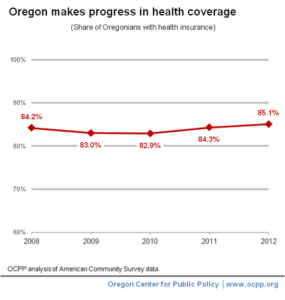
For a second year in a row, overall health insurance in Oregon improved in 2012. The share of Oregonians with coverage rose to 85.1 percent, up from 84.3 percent in 2011 and 82.9 percent in 2010.
With these improvements, the share of Oregonians with health insurance in 2012 exceeded the level at the start of Great Recession. In 2008, coverage stood at 84.2 percent.
In 2012, approximately 3,284,000 Oregonians had health insurance and 576,000 Oregonians remained uninsured.
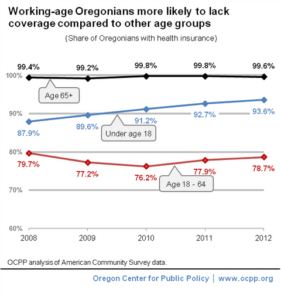
Working-age Oregonians, those ages 18 to 64, gained health coverage for a second year in a row in 2012. That year, health coverage for working-age Oregonians inched up to 78.7 percent.
The gains stemmed mainly from expanded eligibility and increased enrollment in the Oregon Health Plan and new private coverage options for young adults under the Affordable Care Act.[2]
Despite these gains, working-age Oregonians were less likely to have coverage than other groups.
The share of children who are insured has steadily increased since 2008 following the launch of Oregon’s Healthy Kids program.
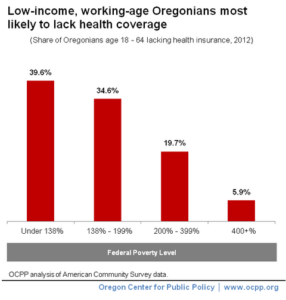
Among working-age Oregonians, those with lower incomes had the greatest coverage gaps.
In 2012, two out of five working-age Oregonians with income below 138 percent of the federal poverty level lacked insurance. Among those with slightly more income — income up to 200 percent of poverty — more than one in three was uninsured.
Combined, the two groups of low-income, working-age Oregonians comprised 57 percent of the state’s uninsured in 2012, despite accounting for just 22 percent of the state’s total population.
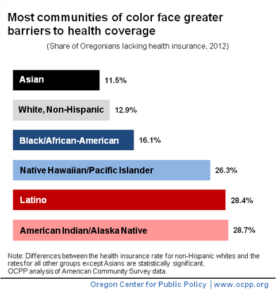
Most communities of color in Oregon experienced greater challenges in securing health coverage as compared to non-Hispanic whites.
In 2012, 16.1 percent of black Oregonians lacked coverage compared to 12.9 percent for non-Hispanic whites.
Native Hawaiian/Pacific Islanders, Latinos and American Indian/Alaskan Natives were more than twice as likely to lack coverage as non-Hispanic whites, having uninsured rates of 26.3 percent, 28.4 percent and 28.7 percent, respectively.
In 2012, the uninsured rate among Asians was not significantly different from the rate for non-Hispanic whites.
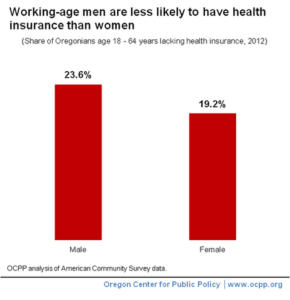
Working-age men in Oregon are more likely to lack health insurance than their female counterparts.
In 2012, about 23.6 percent of Oregon men between 18 and 64 years were uninsured, compared to 19.2 percent of Oregon working-age women.
That year, men working full time, part time and not working were each more likely to be uninsured than women in the same circumstances.
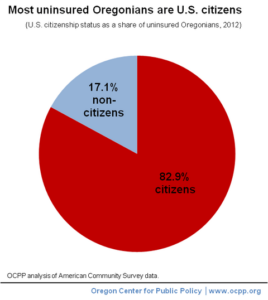
The vast majority of Oregonians lacking health insurance are United States citizens.
In 2012, 82.9 percent of uninsured Oregonians (nearly five of every six) were citizens.
The remaining 17.1 percent of the uninsured were non-citizens. This group included both legally-present immigrants and immigrants without documentation.
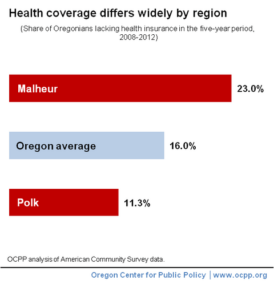
Health coverage in Oregon varies widely by county.
On average, 16.0 percent of Oregon’s population was uninsured during the five-year period 2008 to 2012.[3]
In Malheur county, however, the figure was 23.0 percent over the same period.
By contrast, the share of uninsured in Polk county was 11.3 percent.
A list of the share of people without health insurance by Oregon county appears in Appendix A.
Conclusion
While Oregon has made progress in extending health coverage, the job is not done. Significant gaps remain. These gaps are particularly pronounced among low-income, working-age Oregonians; most communities of color; working-age men and some Oregon counties.
Full implementation of the Affordable Care Act is certain to increase health coverage among Oregonians, but it is unlikely to close all of the gaps. To achieve quality, affordable health coverage for all, Oregon will need to look for additional policy solutions.
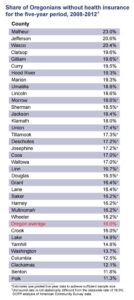
[1] All data referenced in this publication is from the U.S. Census, American Community Survey, which included questions about health insurance beginning in 2008. The most recent data, for 2012, was released in September 2013.
[2] The share of Oregonians between the ages of 18 and 64 enrolled in Medicaid increased by 2.3 percentage points between 2010 and 2012. This increase coincides with two developments: first, enrollment growth in the Oregon Health Plan Plus program for very poor families with children following the Great Recession; second, an increase in Oregon Health Plan Standard enrollment among other poor adults, paid for by an increased hospital tax enacted by the Oregon legislature in 2009. Private coverage among Oregonians age 18 to 24 years old over the period increased by 6.7 percentage points following new Affordable Care Act guidelines requiring insurers to allow young adults to join a parent’s plan until age 26. Private coverage also increased among 25 to 34 year olds by 1.7 percentage points between 2011 and 2012. These gains more than made up for the erosion of private coverage of 2.3 percentage points among 55 to 64 year olds between 2010 and 2012.
[3] County estimates use pooled five-year data to achieve sufficient sample size.
Posted in Health Care.
More about: affordable care act, basic health, health care costs, health insurance, health insurance exchange, health reform, medicaid, oregon health plan, race and ethnicity, swo






